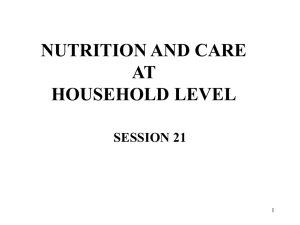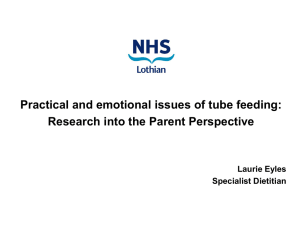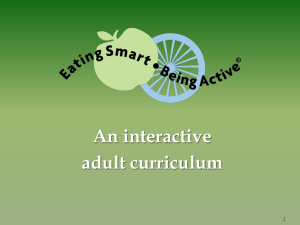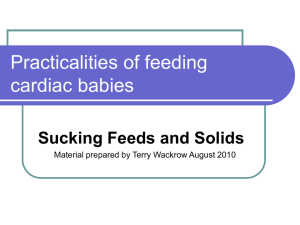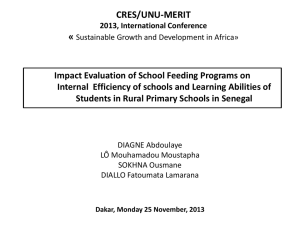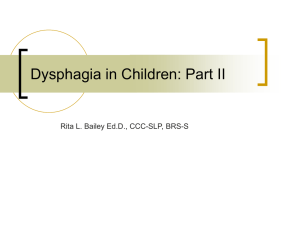District 5 Hot Topics Presentation 10-7-2014
advertisement
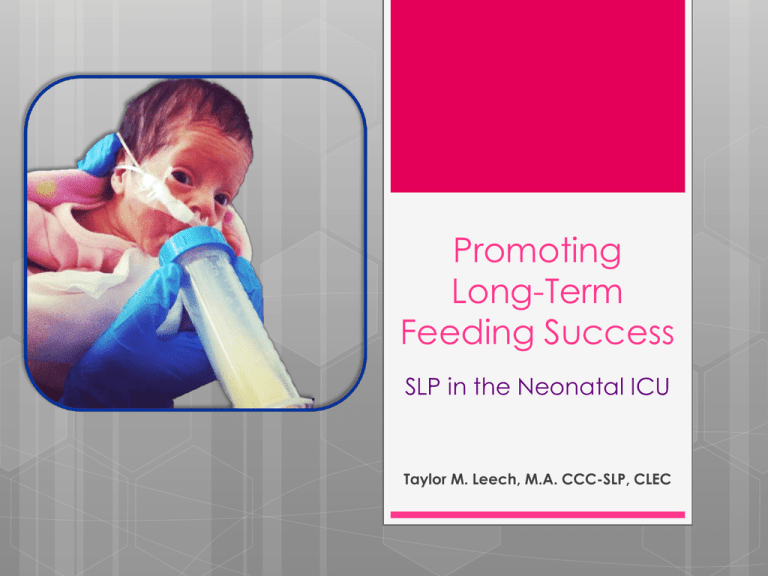
Promoting Long-Term Feeding Success SLP in the Neonatal ICU Taylor M. Leech, M.A. CCC-SLP, CLEC SLPs role in the NICU Short and long term success Traditional vs research based infant feeding Quantity vs Quality Traditional Feeding Techniques in the NICU From an article on about.com by an RN - May 2014 “Sit your baby up” “Use chin and cheek support” “Encourage Nurses to take the tube out” Traditional Feeding Techniques in the NICU And my favorite… Do your exercises: Ask NICU nurses or therapists to show you a series of mouth exercises you can perform on your baby to help prepare her for feeding. Exercises like circling the lips with your fingers, stroking the chin, and gently squeezing the cheeks together can help your baby to feed better. Problems Driven by the caregiver, not the baby Does not take into account what the infant wants Can be over-stimulating Can be unsafe and increase risk for aspiration Is focused on finishing the bottle Short-term success for long-term failure Research-Based Feeding Techniques in the NICU Infant-driven feeding Cue-based feeding Focus on quality rather than quantity Quantity A “good” feeding is finishing the bottle Does not take into account infant’s behaviors or needs Success is dependent on the feeder Quality A “good” feeding may only consist of a few minutes or a few mLs A partnership between caregiver and infant Cue-Based Feeding Protocols What are they? Evidence based practices Implementing in the unit Benefits What’s so important about feeding in the NICU? Infants born under 28 weeks PMA have significant risk for feeding delay Preterm infants are at increased risk of neurologic, gastro-intestinal, and cardiac pre-morbidities that can affect ability to safely feed by mouth Has historically been the primary reason discharge home from the NICU is delayed Obtaining full oral feeding Study by Pickler et al (2009) describes the attainment of oral feeding comparing number of days to full oral feeding, how many bottles an infant was offered a day, and comorbidities Obtaining full oral feeding What is Cue-Based Feeding? On demand feeding schedule vs scheduled feedings In the NICU, maintaining a schedule while following infants readiness cues Focusing on infant’s behaviors before and during feeding times to determine when to start, when to take breaks, and when to stop What is Cue-Based Feeding? Readiness Cues Awake/alert state Squirming Rooting “ooo” face Hands to face What is Cue-Based Feeding? Stress Cues (I’m not ready!) Crying Panicked expression Saluting, finger splay, or extremity extension Drowsy What is Cue-Based Feeding? “In volume-driven feeding, success is measured by how much an infant ingests, and caregivers may use strategies intended to empty the bottle without regard to what the infant communicates Volume-driven caregiving tends to feed past the infant's stop signs, which say, ‘I want to stop, I am done’. Failure to respond to the infant's communication may lead to maladaptive feeding behaviors, learned feeding refusals and long-term feeding aversions. Caregivers often pass on this volume-driven philosophy to parents, for whom feeding becomes something they do ‘to’ their infant, instead of a relationship-based experience through which communicative interactions build trust.” (Shaker, 2013) Kirk et al (2007) Infants fed once per shift and advanced base on behavioral cues Attainment of full oral feeds was significantly less by 6 days PMA for study group using clinical pathway compared to control cohort. Sudharshan et al (2012) Comparison of historical (routine care) vs modern and innovative feeding programs and protocols and attainment of full or partial oral feeds at discharge and one year Ludwig & Waitzman (2007) Describes the traditional feeding practices of focusing on time and volume compared to infant-driven practices focusing on quality and infant cues and behaviors Focus is on infant, improvement of parent education and understanding McClain et al (2012) Infants divided into a control group (standard care gradually increasing number of bottles and amount expected to take) and experimental group (offer bottle only when stable and showing readiness cues) Infants in experimental group transitioned to full oral feeds on average 6.4 days before the control group Puckett et al. (2008) Compared preterm infants born 4-6 weeks early on a cue-based feeding program to a control group • • • No significant difference in weight or weight gain Experimental group had significant difference in length of stay – 4.5 days Experimental group had significantly less adverse events (desaturations, bradycardia, coughing) during and after oral feedings Implementing in the NICU Initiated at CRMC Spring 2014 Readiness scores recorded at each feeding • • • • • 1 – Awake prior to care/touch time, showing readiness behaviors 2 – Wakes during or after cares, showing readiness behaviors 3 – Wakes only briefly during cares 4 – Sleeps through cares 5 – Exhibits stress, caregiver is unable to calm, and/or is physiologically unstable Implementing in the NICU If an infant score 1 or 2, they are offered a bottle or breast fed If an infant scores a 3 or 4, they may be offered breast only if mom is at bedside If an infant scores a 5, they are not offered oral feeding in any form Implementing in the NICU Online education for established nurses In-person education for every new nurse Ongoing education at bedside Reviewing with parents Written education and information for parents at bedside Poor Feeding and Impact on Long-Term Nutrition Thoyre ( 2007) – longitudinal study with followup at 6 to 8 moths born less than 1000g and less than 29 weeks “Healthy” infant with no diagnoses in regards to neurologic, GI, or lung dysfunction • • • 80% reported to have long-standing feeding problems including poor intake, fatigue with feeding, and delayed skills 40% had episodes of aspiration 85% with a diagnosis of GER Poor Feeding and Impact on Long-Term Nutrition Cerro et al. (2002) – longitudinal study of children with very low birth weight (under 1500g) without significant neurological impairment • • • • • 33% of infants vomited frequently 32% were on reflux medications 28% had poor weight gain 27% had reported diarrhea 67% of parents interviewed stated that their children “consistently refused food” Poor Feeding and Impact on Long-Term Nutrition Sweet et al. (2003) – interviewed parents of children at 2 years corrected age that were born less than 600g • • 62% reported feeding problems 29% had G-Tubes at some point Organic vs Behavioral Feeding Problems Behaviors • • • Refusal Gagging Texture preferences GERD Vomiting Poor digestion Weak oral-pharyngeal muscles / Dysphagia Early Intervention in the NICU Promotes early successful nipple feeding Parent and caregiver education to promote long-term success Interventions documented to decrease hospital length of stay and time to attainment of full oral feeds More research – longitudinal studies of infants cue-based feeding protocols and feeding behaviors during infancy and childhood Therapeutic Interventions and Diagnostic Tools Neonatal FEES Devices to measure suck patterns and abnormalities Neonatal FEES FEES – Fibro optic Endoscopic Evaluation of the Swallow Avoids radiation exposure Can be completed at bedside Doctor/Radiologist does not need to be present Parent/Caregiver education Quantified/objective evaluation Quantifying Intra-Oral Pressures During Nutritive Suck Visually measures sucking behaviors and patterns Typical periodicity Prolonged sucking and swallowing without pauses Very irregular References Bird, C. (2014, May 28). Successful tips for bottle feeding your preemie. Retrieved from http://preemies.about.com/od/parentingyourpreemie /a/bottlefeedingtips.htm Cerro, N., Zeunert, S., Simmer, K. N., & Daniels, L. A. (2002). Eating behavior in children 1.5-3.5 years born preterm: parents' perceptions. Journal of Pediatrics and Child Health, 38(.), 72-78. Jadchela, S. R., Peng, J., & DiLorenzo, C. (2012, Jan). Impact of personalized feeding program in 100 NICU infant: Pathophysiology-based approach for better outcomes. J Pediatr Gastroenterol Nutr, 54(1), 62-70. Jadcherla, S. R., Wang, M., Vijayapal, A. S., & Leuthner, S. R. (2009, Oct 8). Impact of prematurity and co-morbidities on feeding millstones in neonates: a retrospective study. Journal of Perinatology, 30. Retrieved from http://www.nature.com/jp/journal/v30/n3/abs/jp2009149a.html Kirk, A. T., Alder, S. C., & King, J. D. (12 Juley 2007). Cue-baed oral feeding clinical pathway results in earlier attainment of full oral feeding in premature infants. Journal of Perinatology, 27, 572-578. Retrieved from http://www.nature.com/jp/journal/v27/n9/full/7211791a.html Lang, W. C., Buist, N. R., Geary, A., Buckley, S., Adams, E., Jones, A. C., Gorsek, S., Winter, S. C., Tran, H., & Rogers, B. R. (2011, Sept 26). Quantification of intraoral pressures during nutritive sucking: methods with normal infats. Dysphagia, 26(3), 277-286. References Continued Ludwig, S. M., & Waitzman, K. A. (2007, Sept). Changing feeding documentation to reflect infant-driven feeding practice. Newborn and Infant Nursing Reviews, 7(3), 154-160. Martin, G. C., Gartside, P. S., Greenberg, J. M., & Wright Lott, J. (30 Jan 2001). A feeding protocol for healthy preterm infants that shortens time to oral feeding. The Journal of Pediatrics, 139(3), 374-379. McClain, G. C., Del Moral, T., Duncan, R. C., Fontaine, J. L., & Pino, L. D. (2012, Nov/Dec). Transition from gavage to nipple feeding for preterm infants with bronchopulmonary dysplasia. Nursing Research, 61(6), 380-387. Pickler, R. H., Best, A., & Crosson, D. (2009, Oct 2). The effect of feeding experience on clinical outcomes in preterm infants. Journal of Perinatology, 29. Retrieved from http://www.nature.com/jp/journal/v29/n2/full/ jp2008140a.html Puckett, B., Grover, V. K., Holt, T., & Sankaran, K. (2008). Cue-based feeding for preterm infants: a prospective trial. American Journal of Perinatology, 25(10), 623-628. Shaker, C. S. (2013, Feb 1). Reading the feeding. ASHA Leader. Retrieved from http://www.asha.org/Publications/leader/2013/130201/Reading-theFeeding.htm Sweet, M. P., Hodgman, J. E., Pena, I., Barton, L., Pavlova, Z., & Ramanathan, R. (2003). Two-year outcome of infants weighing 600 grams or less at birth and born 1994 through 1998. Obstetrics and Gynecology, 101(.), 18-23. Thoyre, S. M. (2007, July/Aug). Feeding outcomes of extremely premature infants after neonatal care. JOGNN, 36(4), 366-376.
